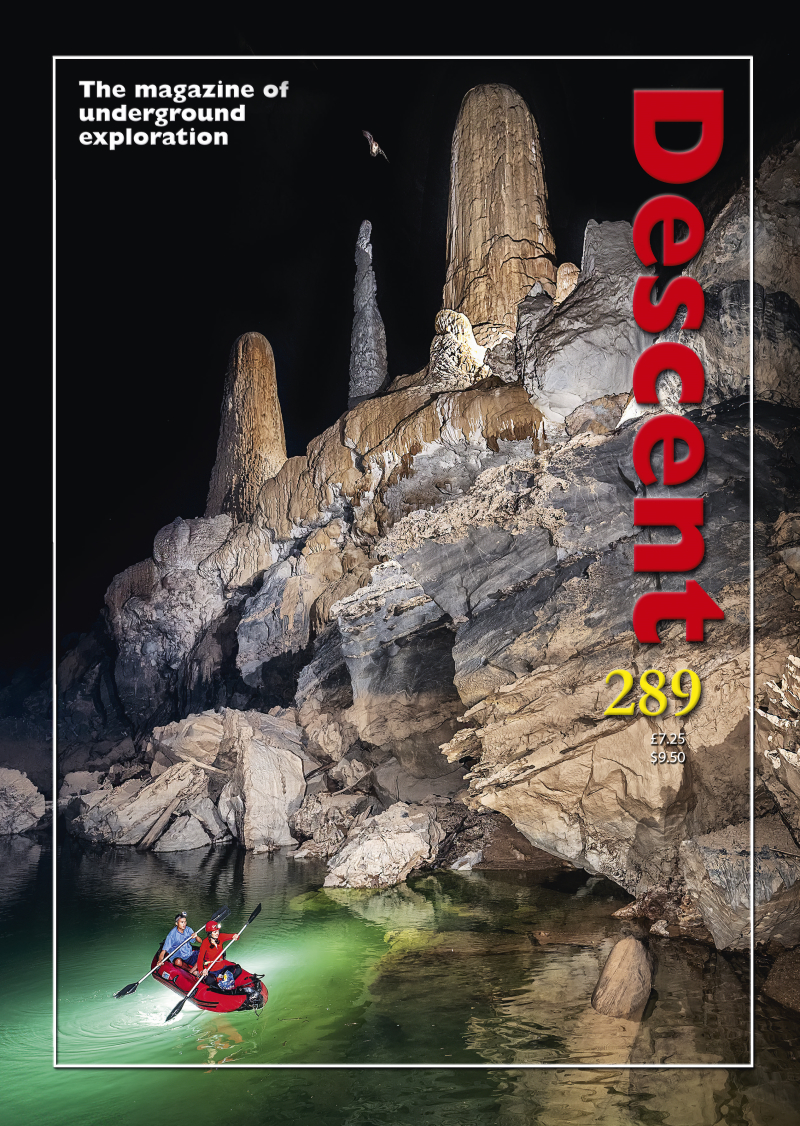
Descent 289 – The first issue under new management, and the verdict is more, please!
Chris Scaife and Carolina Smith will no doubt have been experiencing high levels of adrenaline in recent weeks, as they endeavoured to compose and publish the first issue of Descent since they took over the reins of the magazine from Chris Howes and Judith Calford.
As the new owners’ first issue, Descent 289 does not disappoint. The same high levels of production quality continue, and the content is just as engaging. For now, the format remains much as it has been, and as Chris and Carolina get past the adrenaline-fuelled first few weeks, no doubt we will see new ideas and formats – but all in good time.
The first article we find in this issue is the story of how Descent came to change hands, and some insightful questions and answers in an interview with Chris and Judith about their 34 years running and developing the magazine. There is the usual mix of short news desk stories covering a number of recent cave- and caver-related events, rescue stories, and scientific discoveries. News from UK and Ireland regions is provided by the regular correspondents, and we learn that Elaine Hill is standing down as “North” correspondent, to be replaced by Frank Pearson. The Stoney Middleton Master Cave in the Peak provides much of the news from that area, largely a catalogue of developments in the ongoing investigations in this cave system.
Pete Glanvill provides his perspective on the ever-changing Upper Series of Swildon’s Hole in Somerset, and how over many years he has personally witnessed significant alterations of the various routes through this section, caused by flood events and boulder movements. Paul Taylor provides a detailed and in-depth analysis of recent investigations and explorations in Redhouse Lane Swallet and Slaughter Stream Cave in the Forest of Dean, and news of the premiere screening of the long-awaited Otter Hole film.
In Wales, Martyn Farr gives us his thoughts on the prospects of linking Ogof Agen Allwedd with Ogof Daren Cilau, some advice on caver parking in the Clydach Gorge, and the possibility of a full inquest being held in connection with the fatal mine-flooding that happened in the Gleision Mine in 2011. John Kelly describes recent activity in Badger Pot in County Leitrim, and the main story from the North is a tribute to Lloyd Cawthorne, who has died, tragically aged only 32 years. International news has a single story, the major extension discovered in the Sternes cave system in Crete, in late summer earlier this year.
Two publications are reviewed in Speleo Reader, Caves of southern Ireland, edited by Graham Mullan, and Sistema Cheve Expedition 2021, edited by Bill Stone and Jordan Toles. The former, published by UBSS, is the second in a series of three books. Chris Howes gives it an excellent review, describing it as a model of clarity, along with other glowing terms. The subject of the second review is available as a free download for personal use and is a detailed report of an expedition in 2021 to Sistema Cheve in Oaxaca, Mexico. It is written in Spanish and English. Nancy Pistole’s review describes the publication as being “full of entertaining stories of exploration with accompanying maps”, and a “good resource covering the logistics and challenges of remote underground exploration.”
The remaining articles in Descent 289 comprise seven features on a variety of subjects. The authors of the book “Lechuguilla Cave”, have contributed a few spectacular photographs from that book for Descent readers to appreciate. There is a two-page illustrated article on a recent difficult rescue of a caver stranded at the back of a sea cave in Mayo, and Rainer Straub and Herbert Jantschke report on a surveying project to measure and photograph an extraordinarily large stalagmite in Cueva Martín Infierno, Cuba.
There is a fascinating catalogue of cavers’ accommodation in the Dales, past and present, club-run or otherwise. Readers are invited to make similar contributions for other UK caving regions. Martyn Farr addresses what can be quite a controversial subject: the use of drones in underground spaces. He describes his own experiments, and the technical difficulties that need to be overcome. Whether or not you agree that the practice should be encouraged, learning from those who have attempted to do this responsibly is never a bad thing.
Chris Howes summarises 25 years of investigations in Fishmonger’s Swallet, Gloucestershire, the archaeology of which has attracted the attention of the producers of the TV series Time Team, and others, as well as the scientific analysis of the many bones found, published in UBSS Proceedings (Vol.29,1, for 2022). In the “Write it down” feature, Phil Judson recalls a memorable experience crossing a sloping ice field in the Russian Caucasus in the dark, without adequate protection (wearing wellies!) but surviving the experience, and enjoying the immense relief of getting off the mountain safely.
The tradition of an annual Christmas crossword continues this year – get your answers in to the Descent team by the end of the year and take the chance of winning a small prize.
If you don’t have a subscription yet, then due to the change of ownership you need to visit the new website to set one up.
Correspondent: Peter Burgess
